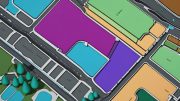Township data plays a crucial role in enhancing the accuracy of property boundaries. Understanding the Section Township Range system is crucial for surveyors and real estate professionals striving for precise land demarcation. By delving into this data, one can decipher the intricate details that govern property lines and ensure a thorough comprehension of land divisions. Let’s explore how this data can revolutionize the accuracy of property boundary determinations.
Section Township Range Data Basics
What is Section Township Range Data?
An crucial component of the Public Land Survey System (PLSS), Section Township Range data is a method of land description used in the United States to precisely identify a property’s location within the grid system. It divides land into a series of squares, allowing for accurate identification and location of parcels.
How is it Used in Property Boundary Determination?
Any professional involved in property boundary determination, such as land surveyors or real estate professionals, relies heavily on Section Township Range data. This data provides a standardized framework for identifying and defining property boundaries, ensuring accuracy and consistency in land descriptions.
Property boundary disputes can be a common issue, and accurate mapping is crucial in resolving conflicts between neighboring landowners. By using Section Township Range data in conjunction with modern surveying techniques, surveyors can precisely locate and mark property boundaries, providing clarity for all parties involved.
Improving Property Boundary Accuracy
Reducing Errors in Property Descriptions
To enhance property boundary accuracy, it is crucial to reduce errors in property descriptions. Utilizing Section Township Range data can help in accurately defining boundaries and minimizing discrepancies in property descriptions.
Enhancing Surveying Efficiency
Property boundary accuracy can be improved by enhancing surveying efficiency. By leveraging Section Township Range data, surveyors can streamline the surveying process, ensuring precise property boundary measurements and reducing the margin of error.
Reducing the time and resources required for surveying not only increases efficiency but also improves the overall accuracy of property boundaries. Surveyors can rely on Section Township Range data to expedite the surveying process and deliver more precise results to property owners.
Applications of Section Township Range Data
Land Use Planning and Zoning
Little can impact land use planning and zoning decisions more than accurate property boundary data. Section Township Range data provides precise information on land divisions, allowing planners to make informed decisions on development, conservation, and infrastructure projects.
Environmental Conservation Efforts
To maximize the effectiveness of environmental conservation efforts, it is crucial to have precise property boundary data. Section Township Range information can help identify key areas for conservation, such as wetlands, forests, or critical habitats.
Efforts to protect sensitive environmental areas can be greatly enhanced by utilizing Section Township Range data, allowing conservationists to target their resources effectively and work towards preserving biodiversity and natural ecosystems.
Summing up
With these considerations in mind, it is evident that utilizing Section Township Range data can greatly enhance property boundary accuracy. By referencing this data, surveyors, real estate professionals, and landowners can pinpoint specific locations with precision, leading to more accurate land assessments and transactions. Embracing this information can streamline processes, minimize disputes, and ultimately contribute to a more sustainable and organized use of land resources.





Be the first to comment on "How Can Section Township Range Data Improve Property Boundary Accuracy?"